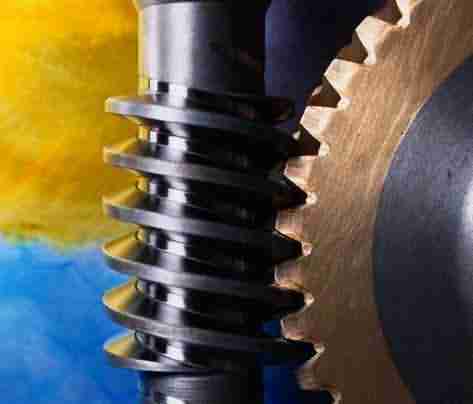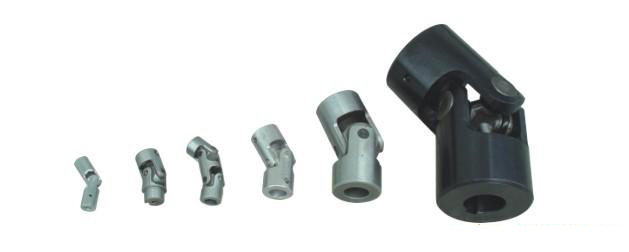GEAR
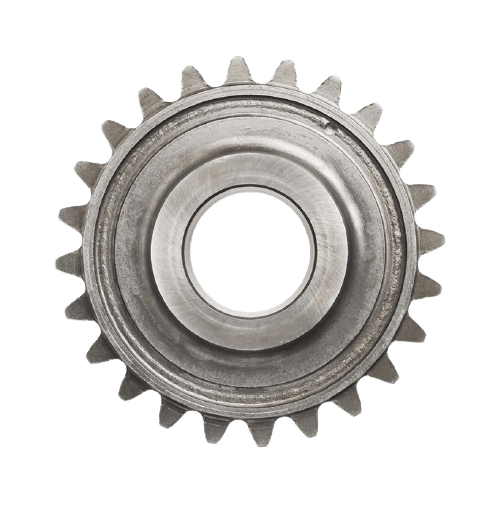
Spur Gears
The most common type of gears employed, spur gears are constructed with straight teeth cut or inserted parallel to the gear’s shaft on a circular (i.e., cylindrical) gear body. In mated pairs, these gears employ the parallel axes configuration to transmit motion and power. Depending on the application, they can be mated with another spur gear, an internal gear (such as in a planetary gear system), or a gear rack (such as in a rack and pinion gear pair).
The simplicity of the spur gear tooth design allows for both a high degree of precision and easier manufacturability. Other characteristics of spur gears include lack of axial load (i.e., the thrust force parallel to the gear shaft), high-speed and high-load handling, and high efficiency rates. Some of the disadvantages of spur gears are the amount of stress experienced by the gear teeth and noise produced during high-speed applications.
This type of gear is used for a wide range of speed ratios in a variety of mechanical applications, such as clocks, pumps, watering systems, power plant machinery, material handling equipment, and clothes washing and drying machines. If necessary for an application, multiple (i.e., more than two) spur gears can be used in a gear train to provide higher gear reduction.
Helical Gears
Similar to spur gears, helical gears typically employ the parallel axes configuration with mated gear pairs, but, if aligned properly, they can also be used to drive non-parallel, non-intersecting shafts. However, unlike spur gears, these gears are constructed with teeth which twist around the cylindrical gear body at an angle to the gear face. Helical gears are produced with right-hand and left-hand angled teeth with each gear pair comprised of a right-hand and left-hand gear of the same helix angle.
The angled design of helical teeth causes them to engage with other gears differently than the straight teeth of spur gears. As properly matched helical gears come in contact with one another, the level of contact between corresponding teeth increases gradually, rather than engaging the entire tooth at once. This gradual engagement allows for less impact loading on the gear teeth and smoother, quieter operation. Helical gears are also capable of greater load capabilities but operate with less efficiency than spur gears. Further disadvantages include the complexity of the helical tooth design, which increases the degree of difficulty in its manufacturing (and, consequently, the cost) and the fact that the single helical gear tooth design produces axial thrust, which necessitates the employment of thrust bearings in any application which uses single helical gears. This latter necessity further increases the total cost of using helical gears.
|
Type of Gear |
Characteristics |
|
Spur |
|
|
Helical |
|
|
Bevel |
|
|
Worm |
|
|
Rack and Pinion |
|
Bevel Gears
Bevel gears are cone-shaped gears with teeth placed along the conical surface. These gears are used to transmit motion and power between intersecting shafts in applications which require changes to the axis of rotation. Typically, bevel gears are employed for shaft configurations placed at 90-degree angles, but configurations with lesser or greater angles are also manageable.
There are several types of bevel gears available differentiated mainly by their tooth design. Some of the more common types of bevel gears include straight, spiral, and hzpt bevel gears.
Straight Bevel Gears
The most commonly used of the bevel gear tooth designs due to its simplicity and, consequently, its ease of manufacturing, straight bevel teeth are designed such that when properly matched straight bevel gears come into contact with one another, their teeth engage together all at once rather than gradually. As is the issue with spur gears, the engagement of straight bevel gear teeth results in high impact, increasing the level of noise produced and amount of stress experienced by the gear teeth, as well as reducing their durability and lifespan.
Spiral Bevel Gears
In spiral bevel gears, the teeth are angled and curved to provide for more gradual tooth engagement and more tooth-to-tooth contact than with a straight bevel gear. This design greatly reduces the vibration and noise produced, especially at high angular velocities (>1,000 rpm). Like helical gears, spiral bevel gears are available with right-hand or left-hand angled teeth. As is also the case with helical gears, these gears are more complex and difficult to manufacture (and, consequently, more expensive), but offer greater tooth strength, smoother operation, and lower levels of noise during operation than straight bevel gears.
왜 우리를 선택해야 할까요?
(1) 우리는 OEM 서비스를 제공하고 다양한 스타일과 최신 디자인을 고객에게 제출합니다;
(2) 당사는 동남아시아, 아프리카, 중동, 북미, 남미의 주요 고객과 협력하고 있습니다;
(3) 다른 지역 고객의 요구에 따라 다양한 스타일의 감속기를 매칭하여 고객이 시장에서 큰 경쟁력을 갖도록했습니다!
(4) 우리는 고객에게 고품질의 제품과 가장 전문적인 서비스를 제공하는 데 20년 이상의 풍부한 경험을 가지고 있습니다!
(5) 중국 내 모든 항구에서 유연하게 상품을 수출할 수 있습니다! 문의 환영합니다!
회사 이점:
1. 대규모 생산 능력과 빠른 배송.
2. 엄격한 품질 관리 검사 규칙: 모든 제품은 배송 전에 100% 검사를 통과해야 합니다.
3. OEM/ODM 서비스 제공
4. 24시간 온라인 서비스.
5. 실시간 견적 조회
6. 고품질, 높은 신뢰성 및 긴 제품 수명.
7. 전문 제조업체가 경쟁력 있는 가격을 제공합니다.
8. 다양하고 숙련된 숙련된 인력.
품질 관리 시스템:
HZPT에서는 제품 및 서비스 품질이 최우선 순위입니다.
직원들은 품질 관리 방법과 원칙에 대한 교육을 받습니다.
조직의 모든 수준에서 제품 품질과 프로세스를 개선하기 위해 최선을 다하고 있습니다.
이러한 깊은 헌신 덕분에 고객의 신뢰를 얻고 전 세계에서 가장 선호하는 브랜드가 될 수 있었습니다.
패키지 및 리드 타임
크기: 도면
목재 케이스/용기 및 팔레트 또는 맞춤형 사양에 따라.
15-25일 샘플. 30-45일 공식 주문
항구: 상하이/닝보 항구
자주 묻는 질문
자주 묻는 질문
고객에게
중국에서 구매하는 것이 수익성이 있나요?
중국은 여전히 세계에서 가장 큰 공급업체 중 하나입니다. 중국은 경쟁력 있는 품질과 가격으로 전 세계에 공급하고 있기 때문에 선택한 제품이 목표 시장에서 수익성이 있는지 확인합니다.
2) 상품을 구매하려면 중국을 여행해야 하나요?
항공료, 호텔 및 여행 경비를 절약할 수 있도록 모든 것을 처리해 드립니다. 하지만 중국을 방문하기로 결정했다면 즐거운 여행 경험이 될 수 있도록 멋진 숙박을 준비해 드리겠습니다.
3) 어떤 유형의 제품을 공급하나요?
다양한 산업, 자동차 및 농업용 제품. 모든 제품은 전문 팀에 배정됩니다.
4) 중국에서 구매하거나 귀하와 협력할 때 어떤 위험이 있나요?
기본적으로 위험이 없습니다. 저희가 구매를 대행해드리고 검수를 통해 안심하실 수 있습니다. 중국에 올 시간이 있다면 생산 공정 중에 방문하실 수 있습니다. 당사의 연락처 네트워크와 영업팀에 액세스할 수 있습니다. 저희와 마찬가지로 귀사의 제품에 대해 진지한 조치를 취할 것입니다. 중국에 지식이 풍부한 파트너가 있으므로 원하지 않는 경우 여행할 필요가 없습니다.
5) 내 제품의 공급업체는 내가 직접 찾을 수 있는데 왜 당신이 필요한가요?
그렇게 할 수 있습니다. 하지만 투자 비용이 훨씬 더 많이 들게 됩니다. 또한 시장을 잘 알고 기회의 네트워크에 액세스할 수 있는 현지 파트너가 없습니다.
중국에서 제품을 구매하려면 공급업체와 계약을 체결할 현지 사무소가 있어야 하고, 수시로 품질 및 수량 검사를 수행할 엔지니어 팀이 있어야 합니다. 원자재 공급처에 대해 알아야 하며, 중요한 것은 아웃소싱을 피하는 것입니다.
6) 어떻게 구성되어 있나요?
저희는 각기 다른 부서에서 모든 측면을 전문적으로 담당하고 있습니다. 물류 지원, 소싱 지원, 검사 지원, 법률 지원 등을 제공할 수 있습니다.
7) 이 서비스는 대기업 전용 서비스인가요?
아니요, 정직과 상호 이익에 기반한 관계로 우리와 함께 비즈니스를 유지할 수있는 따뜻한 신뢰를 얻을 수 있으므로 향후 비즈니스를 확장 할 수 있습니다. 우리는 당신을 돌보고 이전보다 훨씬 더 강해지도록 만듭니다. 함께 힘차게 나아갑니다.
소규모부터 대규모까지 모든 기업을 환영합니다, 진행합시다 ... .
더 궁금한 점이 있으면 이메일을 보내주세요.
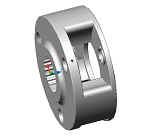

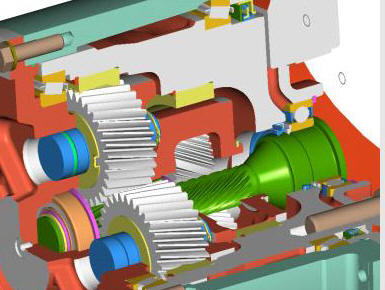

/helica1.jpg)
